The Philippines is hoping that the United States Congress will "reauthorize" the Generalized System of Preferences (GSP) program so that Manila can again enjoy duty-free privileges on some of the products it exports to the US. Established in 1974, the GSP has provided nonreciprocal, duty-free privileges for over 3,500 products entering the US from 119 beneficiary developing countries, including the Philippines. The GSP is the largest and oldest US trade preference program that was instituted to promote economic development in designated beneficiary countries and territories by eliminating duties on thousands of their export products. "If I were to cite two priorities for the Philippine Trade and Investment Center in Washington D.C., these would be the GSP reauthorization and investment promotion," commercial counselor Kenneth Yap told visiting Filipino journalists.
"Of our $11.85 billion merchandise exports to the US in 2021, around $3.1 billion (about 26 percent) are GSP eligible exports," Yap said. The Philippines is one of the top beneficiaries of GSP. "We need our GSP privilege to the US to be competitive against products made in China and Vietnam, both of whom are not GSP countries," he added. The GSP program expired on Dec. 31, 2020 and its renewal "rests chiefly on the US Congress passing a reauthorization bill." "Given the 'buy American' narrative that currently pervades local US politics, reauthorizing GSP is a highly charged subject that most American politicians want to avoid, especially in an election year," Yap said. "Consequently, bills that included GSP renewal have stalled on the floor of Congress these past two sessions." The Philippines "profited greatly as a designated beneficiary country of the GSP program," he said. Even with the GSP program suspended, the total value of GSP-eligible Philippine exports purchased by American manufacturers "rose substantially," Yap pointed out. Moreover, of the top 10 Philippines exported to the US in 2021, three were GSP-eligible items — leather bags (4th), TV and sound recorders (7th), rubber tires (10th) — amounting to almost $1.06 billion. Of the top 25 Philippines exports to the US, seven would be GSP-eligible if the program is reinstituted, with a total value exceeding $1.57 billion. Overall, the $3.1 billion worth of GSP-eligible Philippine export products constitute about 22 percent of the total value ($14.177 billion) of Philippine exports to the US.
For investment promotion, "we believe that we can still get more US investments in Information Technology-Business Process Management specifically in Health Information Management Services," Yap said. "Other areas that we are targeting are, renewable energy such as geothermal, solar and wind and nickel processing for electric batteries where we expect demand as more cars are going electric and hybrid." He noted the US was trying to move away from its dependence on China for electric batteries and critical minerals. In the decade preceding the expiry of the GSP, from 2010-2020, Yap said the Philippines was a consistent top 10 source of US GSP imports, rising as high as 4th in 2019 with a total value of $2.77 billion. "At the time of its suspension in 2020, the GSP-eligible exports of the Philippines to the US dipped slightly to $2.4 billion due to Covid-induced economic slowdown," he said. Yet, when the American economy recovered in 2021, the GSP-eligible Philippine exports to the US surged to over $3.1 billion, which was 30 percent and 12 percent higher compared to 2020 and 2019, respectively, Yap added.
